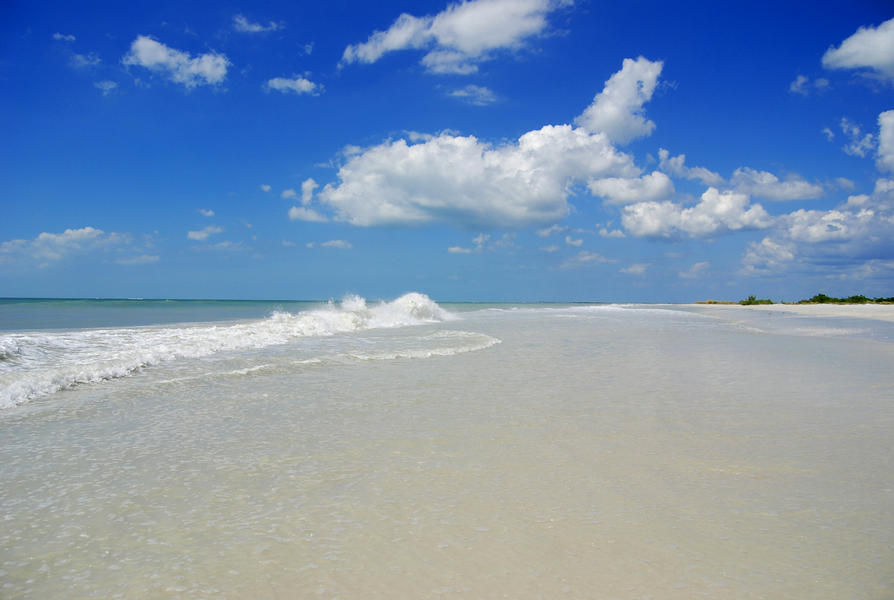Monroe County is Florida’s southernmost county encompassing a diverse range of ecosystems from the mainland down through the Keys.
On the mainland, Monroe is predominantly Everglades National Park, which champions designations as an International Biosphere Reserve, a Wetland of International Importance, and a World Heritage Site. Its mosaic of habitats is home to bobcats, alligators, and the Florida panther. Canoeing, kayaking, boating, fishing, camping, and hiking can all be enjoyed in the park.
The Florida Keys are a coral cay archipelago of over 40 main keys connected by the Overseas Highway and enveloped by the Florida Keys National Marine Sanctuary, which protects 2,900 nautical square miles of the Keys’ turquoise water, mangroves, coral reef, and over 6,000 species of marine life.
The first and longest key is Key Largo. The island boasts John Pennekamp Coral Reef State Park, the first underwater state park in the country. It is acclaimed for its glass bottom boat tours and snorkeling and diving opportunities that allow visitors to observe colorful corals and rich marine life.
A second underwater park, San Pedro State Park, is enjoyed by snorkelers and divers for its submerged shipwreck from 1733 and replica cannons. History enthusiasts will also enjoy exploring the ruins of an early 1800s island town whose residents made their living by salvaging cargo from shipwrecks at the Indian Key Historic State Park. Nearby, Lignumvitae Key Botanical State Park showcases a habitat of tropical hardwood hammock, seagrass, and mangrove where paddlers may encounter manatees, sea turtles, and starfish.
The heart of the Middle Keys is Marathon, a 10-mile-long island community known for its fishing heritage and annual seafood festivals. Anglers from near and far come to the islands to pursue billfish, tuna, and tarpon. Sixty-four acres of hiking and birding opportunities in Marathon can be found at Crane Point Hammock Museum and Nature Trails.
Past Marathon and across the Seven Mile Bridge marks the Lower Keys. Popular state park, Bahia Honda, is renowned for its palm-lined sandy beaches and clear waters, a paradise for snorkelers and kayakers. At night, the park is the darkest location in the Keys for stargazing.
Florida’s southernmost point is the subtropical island city of Key West, famed for aquatic sports, sunset celebrations, and lively nightlife. Local shops, cafes, and art galleries line the streets and historic districts showcase the island’s unique conch style architecture. Visitors also enjoy cultural exhibitions from the Hemmingway Home and Museum, to theatre and live music.
At the furthest end of the Keys across 70 miles of open sea is the Dry Tortugas National Park, composed of 7 keys and named for its large population of sea turtles that bury their eggs on the park’s beaches each summer.
| Monroe at a Glance |
|---|
| Coastal Cities | Key Largo, Islamorada, Marathon, Big Pine, Key West |
| Popular Spot | Key West |
| Sandy Beaches | 26 miles |
| Public Accesses | 47 |
| Great Florida Birding & Wildlife Trail | 10 sites |
| Federal Lands | Acres |
|---|
| Big Cypress National Preserve (Collier, Miami-Dade) | 720,561 |
| Crocodile Lake National Wildlife Refuge | 6,703 |
| Dry Tortugas National Park | 64,701 |
| Everglades National Park (Collier, Miami-Dade) | 1,509,128 |
| Florida Keys National Marine Sanctuary | 2,457,888 |
| Great White Heron National Wildlife Refuge | 117,723 |
| Key West National Wildlife Refuge | 208,308 |
| National Key Deer Refuge | 84,845 |
| Naval Air Station Key West | 6,249 |
| Bays & Inlets |
|---|
| Florida Bay, Whitewater Bay |
| Rivers & Paddling Trails |
|---|
| Bear Lake Trail, Biscayne Bay Blue Way, Broad River, Everglades “River of Grass,” Florida Keys Paddling Trail, Hells Bay Trail, Joe River, Nine Mile Canoe Trail, North River, Shark River, Snake Sight Trail, Gulf Intracoastal Waterway, Florida Circumnavigational Saltwater Paddling Trail |


